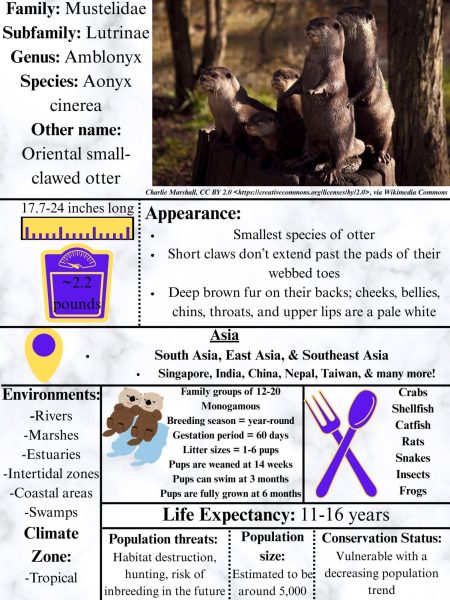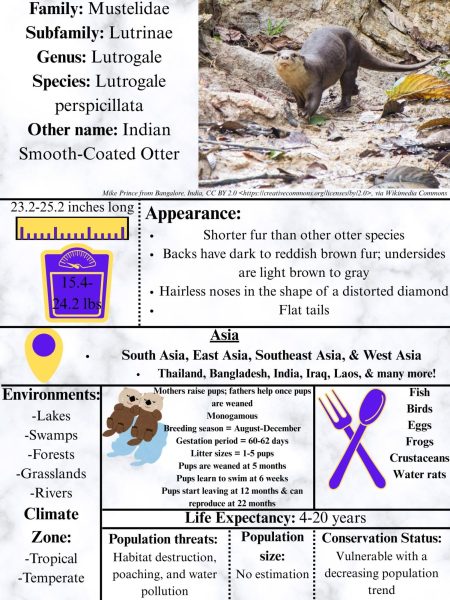Otters. You know why you’re reading about them, right? JVA is the home of the otters; you’re an otter. The picture for the student group in Schoology and the weekly Otter News shows that… and, well, tells that. Our drawn mascot may not have the appearance of real otters–they don’t have abs and can’t stand on just two legs unfortunately–but the spirit is still there. No one can deny that we’re the JVA otters. But what about the real deal? What is the real life animal our mascot is modeled after like? Glad you asked.
As you may remember, there are 13 species of otters. They’re all otters, but there’s still differences between them. What are those differences? Well, let’s take a deeper look at each species to see!
Asian Small-Clawed Otter

Smooth-Coated Otter

An obvious difference between these two species is their genus and scientific name, as well as their appearance. With different species or subspecies differences in color, size, location, family life, and diet can be predicted. However, that is not always the case.
Some similarities include:
Inhabiting the continent of Asia
Living in swamps and rivers
Living in a tropical climate zone
Being monogamous
Carrying pups for around 60 days
Eating frogs and fish
Having habitat destruction and hunting as population threats
Having a conservation status of vulnerable and a decreasing population trend
Some differences include:
Size: smooth-coated otters are quite a bit bigger than Asian small-clawed otters
Color: Asian small-clawed otters have lighter undersides than smooth-coated otters
Location: smooth-coated otters are also in West Asia as well as South, East, and Southeast Asia
Environment: Asian small-clawed otters have a range that expands to the coast while smooth-coated otters have a landlocked range
Climate zone: smooth-coated otters live in a temperate climate as well as a tropical climate
Family life: Asian small-clawed otters form groups consisting of a breeding pair and their grown pups while smooth-coated otter females primarily raise pups until the father helps as they get a bit older; Asian small-clawed otters breed year-round while smooth-coated otters breed in the late summer into winter; Asian small-clawed otter pups get weaned earlier than smooth-coated otter pups; Asian small-clawed otter pups learn to swim later than smooth-coated otter pups; and Asian small-clawed otter pups are mature sooner than smooth-coated otter pups
Clearly these two otter species, living on the same continent, are similar and different in numerous ways. No matter how they live, where they live, or what they eat, Asian small-clawed otters and smooth-coated otters are both amazing animals and deserve all the love!
Have you learned something new about otters? If you did, fear not because there is much, much more to learn. This is just the start; just the dipping of toes into the glorious waters of the otters. Next time you see our mascot, just remember the amazing world of real life otters it is based off of.